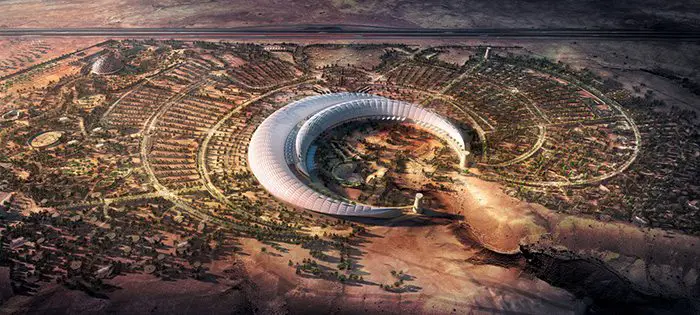Set within the arid desert of the Saudi Central Region, King Abdullah International Gardens have been designed to become a world-leading focus of mankind’s understanding of the process, consequence, and study of Climate Change. The development will capture and display extraordinary ecotopes from history and from the present day, and present the choices that are available to humankind.
The centerpiece of the project is a 90.000 sqm paleobotanic biome building. This is formed as two interlocking crescents that accommodate a sequence of controlled environments. Each environment shall allow visitors to travel through time and experience the changes to plant life and landscape that have occurred where the gardens will be created.
Each garden, on the other hand, is to be presented as a complete environment. They will include plant species from each era that survive to this day and accommodate the ‘ghosts’ of species that have been lost. The gardens are presented as a timeline that leads visitors through different botanical epochs. The gardens will thus cover the prolific Jurassic and Cretaceous periods, the Devonian era, followed by the Carboniferous, Cenozoic, and Paleobotanic periods.
The final enclosed garden within the crescent building is the Garden of Choices. This will be an educational space that explores and explains how the lifestyle and industrial choices we collectively make today could change the landscape in different ways for future generations.
Upon completion, reportedly in the by Autumn of 2024, the development will not only become World’s newest botanical garden but also the largest temperature-controlled garden in the world. King Abdullah International Gardens will rival others of its kind in Kew and Singapore.
Reported On Jul 23, 2014
King Abdullah International Gardens
The 160-hectare King Abdullah international gardens will house many species including a butterfly sanctuary. KAIG plans to incorporate techniques in power generation and water conservation designed to ensure minimal environmental impact. The park’s power requirements will be received supply through on-site renewable technologies such as solar, wind, and combined heat and power sources.
The project’s water conservation will maximize aid from massive underground reservoirs. The reservoirs will also allow for storage with minimal evaporation. Additionally, the underground reservoirs will recycle grey water throughout the site.
